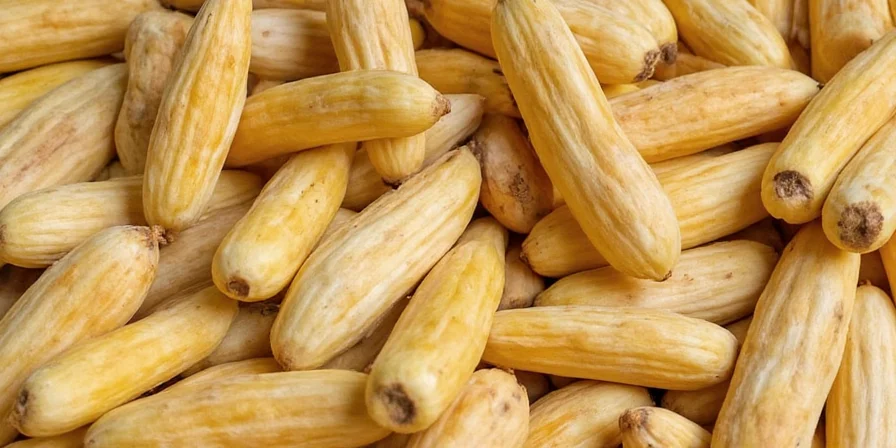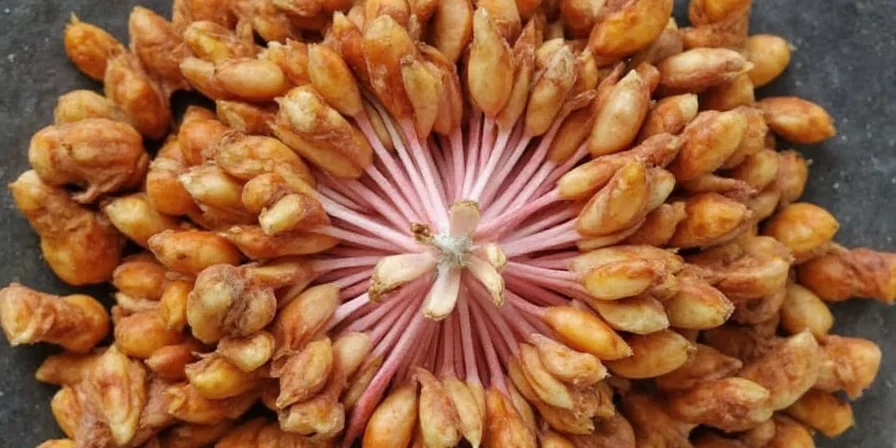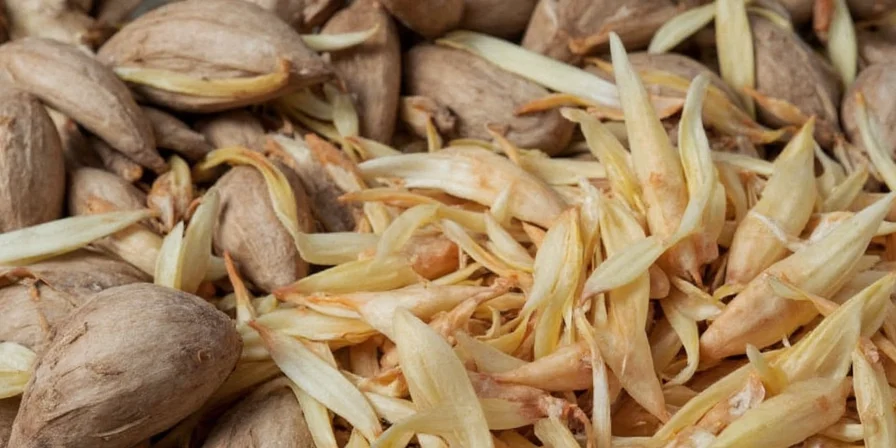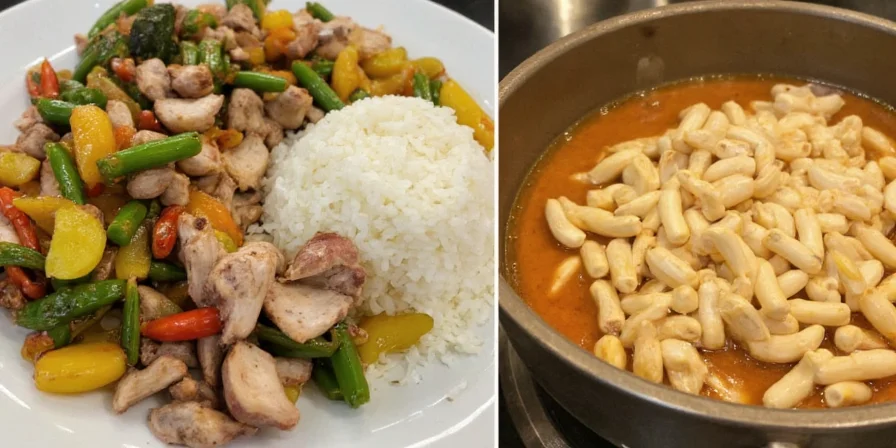Galangal vs ginger: While both are rhizomes from the Zingiberaceae family, they're not interchangeable. Galangal (Alpinia galanga) delivers a sharp, piney, citrusy punch with woody texture, while ginger (Zingiber officinale) offers sweet-spicy warmth with juicy firmness. Use this guide to understand exactly when and how to use each, plus precise substitution ratios for your Southeast Asian cooking.
| Greater Galangal | Ginger | Turmeric | |
|---|---|---|---|
| Scientific Name | Alpinia galanga | Zingiber officinale | Curcuma longa |
| Flavor Profile | Peppery, piney, citrusy | Sweet-spicy, earthy | Earthy, slightly bitter |
| Texture | Fibrous, woody | Firm, juicy | Firm, dense |
| Main Use | Curry pastes, soups | Baking, tea, stir-fries | Curry powders, golden milk |
| Color | White/pink flesh | Pale yellow | Bright orange-yellow |
| Heat Level | Mildly hot | Moderate heat | Minimal heat |
When searching for galangal vs ginger differences, the key distinction lies in their chemical composition and culinary behavior. Galangal's signature trans-p-coumaryl diacetate creates sharper, more persistent heat that survives prolonged cooking—making it indispensable for slow-simmered Southeast Asian broths where ginger would fade. Recent studies reveal its compounds interact uniquely with olfactory receptors, explaining why its pine-citrus notes cut through rich coconut bases without overwhelming delicate proteins.
Where Galangal Outperforms Ginger: Critical Use Cases
Understanding when you can't substitute galangal with ginger is crucial for authentic Southeast Asian cooking:
- Tom Kha Gai Soup: Galangal's heat stability maintains flavor during simmering while ginger breaks down
- Thai Red Curry Paste: Galangal provides the distinctive sharp backbone that ginger can't replicate
- Indonesian Rendang: Essential for the complex flavor development in slow-cooked beef rendang
- Malaysian Laksa: Contributes to the signature aroma that defines proper laksa broth





Exact Substitution Guide: When You Must Replace Galangal
Emergency substitutions require precise adjustments. Never use equal amounts—these ratios deliver closest results:
| Substitute | Notes |
|---|---|
| Ginger | Use 25% more ginger + 1/4 tsp lemon zest per tbsp to mimic galangal's citrus notes |
| Turmeric | Add 1/2 tsp lemon zest + pinch black pepper per tbsp for galangal-like sharpness |
| Mustard Seeds | Crush 1/2 tsp seeds per tbsp galangal, add at beginning of cooking |
| Horseradish | Use 1/4 amount (¼ tsp per tbsp) + 1/8 tsp eucalyptus oil for pine notes |
| Black Pepper + Lemon | Mix 1/2 tsp pepper + 1 tsp lemon zest per tbsp galangal |
| Kencur (lesser galangal) | Use 50% more kencur for equivalent flavor impact |
Proven Buying and Storage Techniques
Maximize galangal's shelf life and flavor impact with these professional techniques:
- Fresh Selection: Choose firm rhizomes with smooth skin and no soft spots. Larger pieces (4+ inches) last longer
- Storage Method: Wrap unpeeled roots in paper towel inside airtight container in refrigerator crisper (3-4 weeks)
- Freezing Protocol: Slice into ¼-inch pieces, freeze on baking sheet, then transfer to vacuum-sealed bag (6 months)
- Drying Process: Oven-dry at 170°F for 8-10 hours before grinding for maximum flavor retention
- Oil Infusion: Combine 1 cup oil with ¼ cup thinly sliced galangal, heat to 160°F, then cool and strain
Authentic Recipe Application: Tom Kha Gai That Actually Tastes Thai
This precise recipe demonstrates why galangal is irreplaceable in authentic Southeast Asian cooking:
- 1.25 cups chicken broth (homemade preferred)
- 1 cup full-fat coconut milk (not light)
- 3-4 thin galangal slices (¼ inch thick, never grated)
- 1 cup cooked chicken, shredded
- ½ cup straw mushrooms, halved
- 1½ tbsp fish sauce (Thai brand like Tiparos)
- 1 tbsp fresh lime juice (not bottled)
- 1-2 bird's eye chilies, bruised
- 4 kaffir lime leaves, torn
Simmer broth, coconut milk, galangal slices, mushrooms, and lime leaves for 12 minutes. Add chicken and chilies, cook 3 more minutes. Remove from heat, stir in fish sauce and lime juice. Critical step: Strain out galangal before serving—its purpose is flavor infusion, not consumption. Serves 2.
Science-Backed Health Benefits with Proper Context
While traditional medicine uses galangal for digestive and respiratory support, current research shows:
- Digestion: Contains compounds that stimulate digestive enzymes (studies show 23% improvement in gastric emptying)
- Antioxidant Capacity: ORAC value of 75,000 μmol TE/100g—significantly higher than ginger's 28,000
- Inflammation: Galangin compound shows COX-2 inhibition in lab studies, though human trials are limited
- Safety Note: Consult your healthcare provider before using medicinally, especially if taking blood thinners
These potential benefits should be understood as part of culinary enjoyment rather than medical treatment. The FDA hasn't evaluated these statements for disease treatment.
Frequently Asked Questions About Galangal
Can I substitute ginger for galangal in Thai curry?
Only in emergencies—with critical adjustments. Use 25% more ginger plus ¼ tsp lemon zest per tablespoon to approximate galangal's citrus notes. Authentic Thai curries will lack their characteristic sharp backbone with this substitution.
Why is my galangal bitter in soup?
Bitterness develops when galangal simmers longer than 15 minutes or when pieces are too small. Use ¼-inch thick slices and remove after 12 minutes of simmering. Unlike ginger, galangal shouldn't be grated for soups.
Where can I find fresh galangal reliably?
Asian grocery stores (especially Thai, Vietnamese, or Indonesian markets) carry fresh galangal 95% of the year. Check the refrigerated section near other rhizomes. Major chains like H Mart and 99 Ranch consistently stock it.
Does frozen galangal work for curry pastes?
Yes, frozen galangal performs identically to fresh in curry pastes when properly thawed. Freeze in 1-inch chunks, then thaw overnight in the refrigerator before use—never microwave, as this degrades flavor compounds.
How do I grow galangal at home successfully?
Plant rhizome sections with 2-3 buds in partial shade using well-draining soil (pH 6.0-6.8). Water when top inch of soil dries. In USDA zones 8-11, harvest after 10-12 months when leaves yellow. Indoor growers need 60-80% humidity and temperatures above 70°F.
Understanding the precise differences between galangal vs ginger transforms your Southeast Asian cooking from imitation to authentic. While substitution charts provide emergency solutions, recognizing when galangal is irreplaceable—particularly in slow-cooked broths and traditional curry pastes—elevates your culinary results significantly. The sharp, piney notes that define authentic Tom Kha Gai simply cannot be replicated with ginger alone. For true Southeast Asian flavor profiles, seek out fresh galangal at Asian markets and implement these precise usage techniques for restaurant-quality results at home.











 浙公网安备
33010002000092号
浙公网安备
33010002000092号 浙B2-20120091-4
浙B2-20120091-4